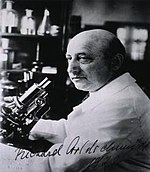
Richard Goldschmidt
Academic
1878 – 1958
Who was Richard Goldschmidt?
Richard Benedict Goldschmidt was a German-born American geneticist. He is considered the first to integrate genetics, development, and evolution. He pioneered understanding of reaction norms, genetic assimilation, dynamical genetics, sex determination, and heterochrony. Controversially, Goldschmidt advanced a model of macroevolution through macromutations that is popularly known as the "Hopeful Monster" hypothesis.
Goldschmidt also described the nervous system of the nematode, a piece of work that later influenced Sydney Brenner to study the wiring diagram of Caenorhabditis elegans an achievement that later won Brenner and his colleagues the Nobel Prize in 2002.
We need you!
Help us build the largest biographies collection on the web!
Citation
Use the citation below to add to a bibliography:
Style:MLAChicagoAPA
"Richard Goldschmidt." Biographies.net. STANDS4 LLC, 2024. Web. 24 Apr. 2024. <https://www.biographies.net/people/en/richard_goldschmidt>.

Discuss this Richard Goldschmidt biography with the community:
Report Comment
We're doing our best to make sure our content is useful, accurate and safe.
If by any chance you spot an inappropriate comment while navigating through our website please use this form to let us know, and we'll take care of it shortly.
Attachment
You need to be logged in to favorite.
Log In